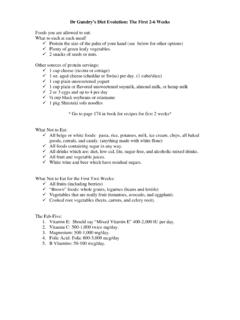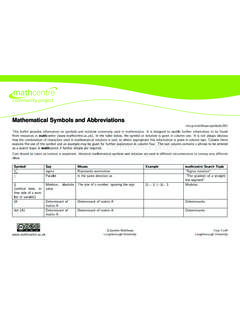Transcription of Faber Castell 2/83N (and 62/83N) instructions in …
1 instructions Precision Slide Rulefor Mechanical and Electrical Engineers,Students of Technical Universities,Engineering Colleges, PolytechnicsNo. 2/83N , 62/83 Nwith enlargedscale rangeThe Castell 2/83 N with enlarged scale rangeMany satisfied users of the 2/83 N slide rule, in a sprit of constructive criticism, have suggested that the arrangement of the scales on the front and back should be improved. Our DevelopmentDepartment has taken advantage of the experience gathered during these last few years and utilised the latest knowledge acquired. Apart from numerous minor improvements, the scales A, B, DI(on the front) and LL00, CI, D and LL0 (on the back) have been Scales of the pocket slide rule 62/83 N with graduation length 5" ( cm)The Scale ST and the Mark on Scales C and DThe Scales of the Slide Rule 2/83 NCalculations with Complex NumbersHow to read the Scales with graduation length of 10 inchesCalculations with the Root Scales W1, W1', W2, W2'How to read the Scales with graduation length of 20 inchesCalculations with the Mantissa Scale LMultiplicationThe Exponential Scales LL1, LL2 and LL3 for positive exponents.
2 LL01, LL02 and LL03 for negative exponentsMultiplication with Scales C and D of back of slide ruleThe Natural LogarithmsDivisionPowers of eCombined Multiplication and DivisionRoots of eFormation of TablesPowers of any numbers desiredCalculations with Scales CI and DIRoots of any numbers desiredCalculation with the Square Scales A and BThe Logarithms to "Base 10"Squares and Square RootsLogarithms to any desired baseCubes and Cube RootsMeaning of the Scale MarksCalculations with the Scales CF, DF and CIFThe CursorCalculations with the Pythagorean Scale PThe Care of the Slide RuleCalculations with the Trigonometrical Scales S, T1 and T2 The scales of the pocket slide rule 62/83 N with graduation length 5" ( cm)From graduation figure 1 to graduation figure (Section of scale reading 1 to 2)From graduation figure 2 to graduation figure 3.
3 (Section of scale reading 2 to 5)From graduation figure 5 to graduation figure 7.(Section of scale reading 5 to 10)Each interval is equivalent to 2 sub sections. An accuratereading can be taken of the values corresponding to 3 odd numbers are obtained by halving the distance betweentwo graduation interval is equivalent to 5 sub sections. This provides anaccurate reading of the values corresponding to 3 places, if thelast figure is a interval is equivalent to 10 This provides anaccurate reading of the values corresponding to 2 places, whichmore over are identified by graduation intermediate values must be estimated. Example: To set to 318, first find by halving the distance between 315 and 320, and then move the cursor line slightly to the Castell 2/83N (and 62/83N) instructions in Englishfile:///C|/SlideRules/WebPage/a-t o-z/fc283n/ (1 of 20) [03/03/2001 13:28:27] The Scales of the Slide Rule 2/83 NAll scales are marked with reference to the basic scales C and D.
4 At the end of the slide rule they bear the mathematical formula based on the numbering of the basic cursor, entirely surrounding the slide rule, enables each stage of the calculation to be connected with the next, throughout all the scales on the front and back of the slide on the front of the slide rule:1st tangent scaleT1tan x (cot)on upper body2nd tangent scaleT2tan x (cot)cube scaleKx3fixed square scaleAx2fixed scaleDF xmovable scaleCF xon slidemovable square scaleBx2reciprocal scaleCIF1 : xreciprocal basic scaleCI1 : xmovable basic scaleCxfixed basic scaleDxon lower bodyfixed reciprocal basic scaleDI1 : xsine scaleSsin 0 1 x (cos)arc scale for small anglesSTarc xPythagorean scaleP (1 . ( x)2) Scales on the back of the slide rule:exponential scales for negative upper 1 0012nd fixed root scaleW2( 10)xon slide2nd movable root scaleW2' (10x)reciprocal basic scaleCI1 : xmantissa scaleL log xmovable basic scaleCx1st movable root scaleW1' x1st fixed root scaleW1 xFaber Castell 2/83N (and 62/83N) instructions in Englishfile:///C|/SlideRules/WebPage/a-t o-z/fc283n/ (2 of 20) [03/03/2001 13:28:27]on lower bodyfixed basic scaleDxand exponential exponential scales for positive exponentsLL1e0 01xLL2e0 1xLL3exHow to read the scales with graduation length of 10 inches, C, D, CF, DF, CIFThe following should be noted:The slide rule does not show the actual place of decimals to which a number belongs.
5 For example, the 6 shown on the slide rule may equally well denote 6, , 60, 600, 6000 or , and soforth.(An exception is provided by the exponential scales) The position of the decimal point is ascertained afterwards, by a rough calculation with round figures. In most practical calculations it is knownin advance, so that no further rules for determining the decimal point are required. It is the basic scales C and D that give the clearest idea of the way in which the scales are Oncefamiliar with the graduation of these two scales, we shall be able to understand the others scales marked in red run in the opposite direction (reciprocally) from right to left, the exceptions being the extended supplementary graduations which are provided to enable a calculation tobe continued in the case of border line values just below 1 (beginning of graduation) or just above 10 (end of graduation).
6 Let us now have a look at the basic scales C and D on the front of the slide rule, the reading . and setting . exercises being carried out by means of the long cursor line or the (beginning ofscale) or (end of scale), as the case may section of the from I to 2(Scales C and D)From 1 to 110 of 10 intervals each (=1/100 or 0 01 per graduation mark)Here an accurate reading can be immediately taken to 3 places ( ). By halving the space between two graduation marks, 4 figures can be accurately set ( ). In all cases the finalnumber must then be a section of the from 2 to 4(Scales C and D)From 3 to 410 of 5 intervals each (= 1/50or 0 02 per graduation mark)Here an accurate reading can be immediately taken to 3 places ( ).
7 The last number is then always even (2, 4, 6, 8). If the intermediate spaces are halved, this provides the unevennumbers (1, 3, 5, 7, 9) as well ( ). Faber Castell 2/83N (and 62/83N) instructions in Englishfile:///C|/SlideRules/WebPage/a-t o-z/fc283n/ (3 of 20) [03/03/2001 13:28:27]A section of from 4 to 10 (Scales C and D)From 8 to 9 1010 of 2 intervals each (= 1/20or 0 05 per graduation mark)Here an accurate reading can be taken to 3 places, when the last number is a 5 ( ). By halving the intermediate spaces it is even possible to take an accurate reading to 4 places. Here again thelast number is always a 5 ( ).How to read the scales with graduation length of 20 inches: W1 W1' W2 W2'These scales are provided along the edges and adjacent edges of the slide, on the back of the slide rule, and run from 1 to at the bottom and from 3 to 10 at the top.
8 Their use results in doubledaccuracy. They are differently, however, from the scales on the 10 inch range from 1 to section is first of all divided into ten , marked 1 1, 1 2, 1 3, 1 Each of these, in turn, is divided into ten further , but the latter are not numbered, owing tolack of space. Finally, a small stroke is also provided to show the exact centre between these graduation marks. Readings can be taken as follows: , , , , from 2 to again, this section is first of all divided into tenths, but they are not numbered, except for the graduation marks corresponding to the values 2, , 3, 3 5. 4, and 5. The user mustrecognise the remaining tenths for himself, the values 2 1, 2 2, .. to 4 7. , 4 tenths are entered In between these tenths but without "marked centres".
9 We thus hove the following values, starting with 2 and without using the decimal point: , , , , , , etc., up to , , , from 5 to this range, the tenths first of all appear, as before, but in between these it is only the fifths that are with 5, we thus have the following graduation marks: , , , , , , , etc. up to , , reading range of these scales exceeds by far these possibilities. Further intermediate values, however, must be estimated. Multiplicationa bThis is chiefly carried out with the main scales C and D of the front of the slide : x 3 = the 1 of the slide of the rule (C 1) above the 2 45 on the lower scale of the slide rule (D245), move the cursor line (Important: Whenever the cursor line is mentioned in this and the followingchapters, this will always refer to the long, central hairline on the front and the back of the cursor.)
10 Intoposition above the 3 of the lower slide scale (C 3) and read the product . 7 35 . underneath thecursor line on the lower scale of the slide rule (D 735).Multiplication with Scales A and B: see belowExample: x = Place C 1 above D , place the cursor line above D , and read the result .. on D, likewise underneath the cursor : x = 48 35. Place C 1 above D , place the cursor line above C , and read the result . 48 35 . on D, likewise underneath the cursor Castell 2/83N (and 62/83N) instructions in Englishfile:///C|/SlideRules/WebPage/a-t o-z/fc283n/ (4 of 20) [03/03/2001 13:28:27]In calculations on the lower scales C and D it sometimes happens that with the setting C 1 above the first factor on scale D the slide projects too far to the right, so that it is no longer possible toset the second factor on of the slideExample: x = 36in this case the slide is pushed to the left until the beginning C 1 is replaced by the end of theslide C 10 (marked 1) above the first factor on scale operation is termed transposing the slide.






